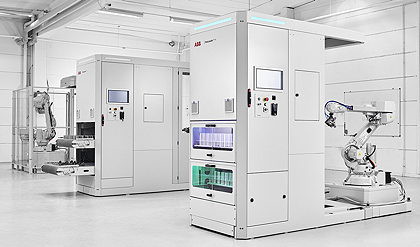- Home » News » Product News
Modular machine-tending cells can cut labour costs by 90%

ABB has launched a family of modular, robotic machine-tending cells for the metals industry that offer a variety of ways of loading and unloading machines, based on the size, shapes and number of workpieces being handled. It claims that the FlexLoader M cells will cut labour costs for machine-tending processes by up to 90%, with one operator able to handle up to 10 cells simultaneously. The automated system is also said to deliver machine utilisation of more than 97%, compared to 40-60% for manually operated machines.
The FlexLoader M family will consist of six different versions, with tray and conveyor variants being the first to be launched, and the others – including AGV, bin, zero-point, and random-feed varieties – due for release in the coming months. They are designed to maximise flexibility and machine utilisation, while minimising productivity losses caused by unforeseen production stoppages. They are suitable for applications such as foundries and die-casting operations that produce multiple types of products in varying quantities.
“As customers demand greater variety and shorter delivery times, metals producers need to have a manufacturing process that can respond quickly and offer the flexibility to achieve high mix, low volume and batch size one production,” explains Andrea Cassoni, managing director of ABB Robotics’ General Industry business. “FlexLoader M is accelerating this move by providing a single unified machine-tool-tending platform offering the flexibility needed for handling a wide variety of production demands, whilst also improving productivity by eliminating the time, cost and disruption traditionally associated with production changes.”
Using interchangeable standardised modules, the FlexLoader M can tend machines such as lathes, mills, CNC and machining centres. The base machine stays the same, with the in and out feed modules being exchanged as requirements change. The modular approach makes upgrading and scaling up easy, with just one to two days typically being needed for installation and commissioning.
The conveyor version uses a vision system to simplify the loading of workpieces with complex shapes, allowing one cell to handle a variety of workpieces. The tray version has a small footprint that allows it to be located almost anywhere, to handle workpieces with variable shapes such as cubes, cylinders, plates and pipes.

ABB says that the FlexLoader M meets the demand for simple automated systems that produce more workpieces in less time. The cells are quick to program, even by users with no robotics expertise. A smart wizard allows new workpieces to be programmed in less than five minutes with no vision programming expertise being needed, while changeover between pieces which are already programmed can be done in less than a minute, making “batch size one” production a reality. The simplicity of the programming software means that operator training takes less than half a day, further reducing the time needed to put cells into operation.
All of the variants can be equipped with vision systems that identify a workpiece’s position and give commands to the robot, machine tools and other cell equipment such as air-cleaning stations, part marking, deburring and measurement systems. The vision systems can use either 2D or 3D sensors, depending on the application.
The FlexLoader M replaces ABB’s previous FlexLoader cells, delivering benefits that are said to include higher machine tool utilisation, and the opportunity for lights-out production through unmanned operation.
ABB Robotics: Twitter LinkedIn Facebook





